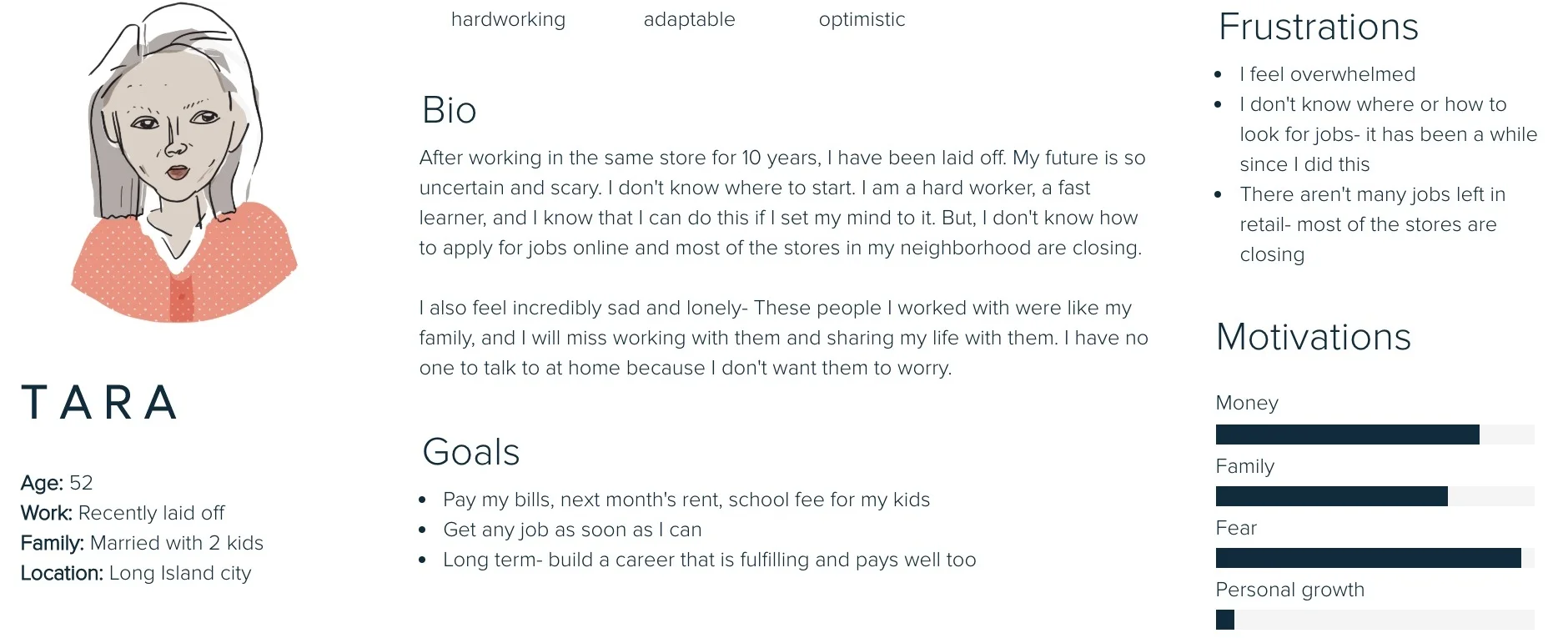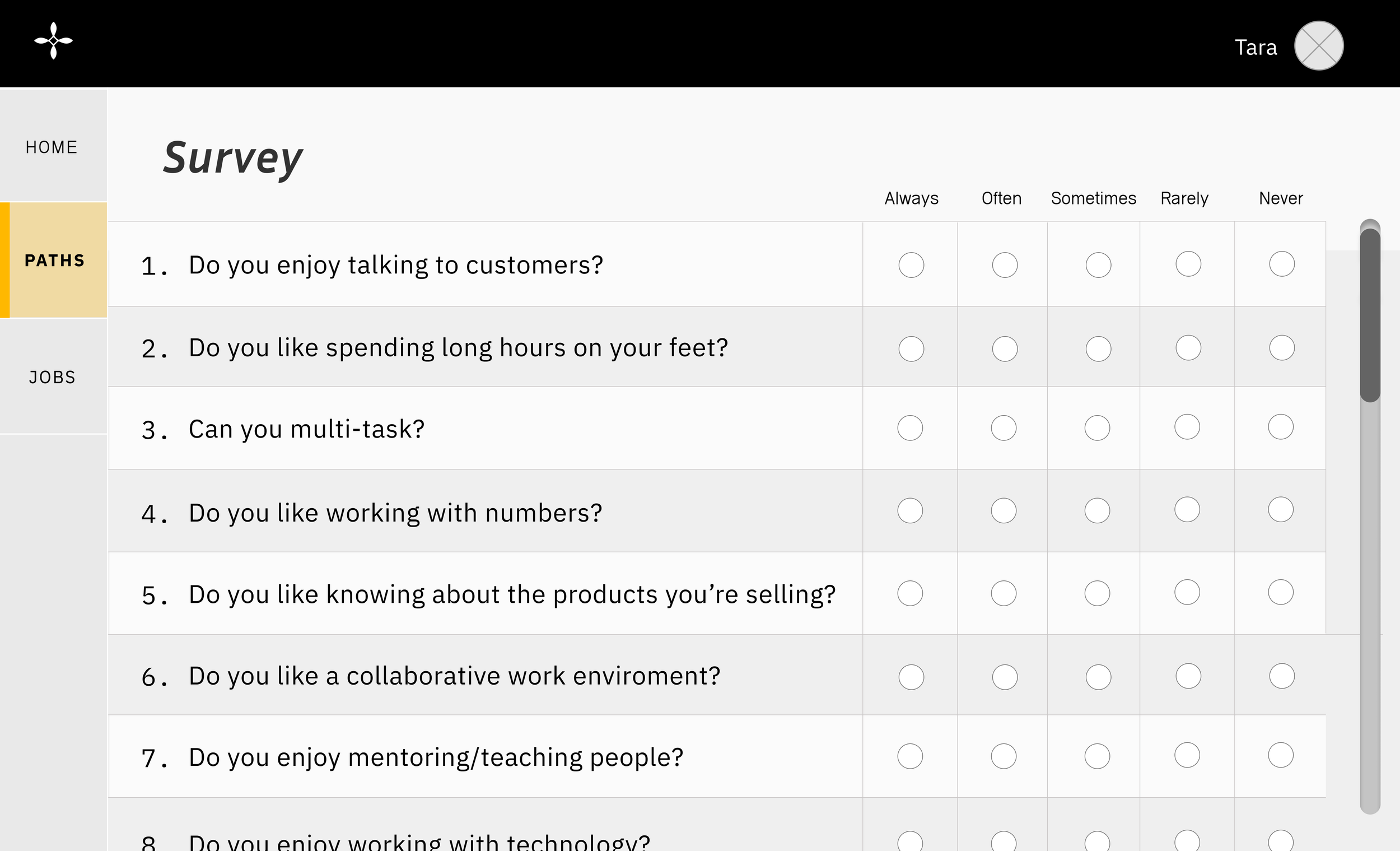A Web Platform That Identifies Transferable Skills
Keywords: User research, Social impact design, Workplace of the future
Tools: Balsamiq, Adobe Illustrator, Invision
Team: Amarildo Gjondrejiak, Kevin Clemens, Marissa Joseph, and Varun Narayan
Role: Design research, UI design
How might we better prepare retail workers for automation, to ensure they have the necessary skills to continue working in the workplace of the future?
THE PROBLEM
Automation poses a risk to workers in the retail sector, with an estimated 6-7.5 million retail jobs at stake in the next decade. (source).
However, if we shift our focus from jobs to tasks, the landscape doesn't seem bleak anymore. Automating parts of the process provides an opportunity for workers to transition to different roles (source).
THE SOLUTION
A web platform that helps identify transferable skills and matches individuals with alternate roles and industries.
Leverages existing job search platforms, and filters the results based on how well an individuals’ existing qualifications align with the job description.
Acquaints users with the job requirements– both general (resume, cover letter, references) and those that pertain to a specific job (certifications, years of experience, preferred skills, etc.). Also gives access to local re-training links to help one upskill.
Storyboard
Process
Interviewing Workers
Our team spoke to 20 individuals working in industries like plumbing, food and beverages, and retail.
Key Insights–
- The workers mostly leveraged their network to find jobs
- They were willing to change career paths
- 75% did not apply online, because they felt it would not materialize into any job opportunities
Posting Jobs on Craigslist

Our team posted three job listings on Craigslist.com, for a Home health aide (HHA), a customer service representative (CSR), and a front desk assistant (FDA)
The assumptions we were testing for–
- Does our user (middle-skilled retail worker) search and apply for jobs online?
- Is our user willing to move to a different role in the same industry?
- Is our user willing to move to a different role in an alternate industry?
Key Insights–
We received 316 applications in 15 days. The breakdown is as follows: HHA- 41, CSR-108, FDA- 168, Unknown- 3. Here are some observations.
- People's perception of an industry matters– The least number of job applications were for the Home Health Aide position. We hypothesize that generally, these positions require standard certification(s)/specialized knowledge. So, individuals from other industries may not look for roles/ jobs in such industries- even though entry-level positions do exist.
- Individuals apply for jobs in industries other than those they have prior experience in– For instance, only 25 of the 108 people who applied for the role of a customer service representative had related work experience. Thirteen individuals (out of 316) simultaneously applied to two job postings.
- A wide variety of resumes and cover letters – There was no standard template that individuals followed regarding the visual design and the content blocks they included. Many individuals had outdated resumes, which had no relevance to the job they were applying to.
Applying For Jobs Using Different Resumes

We created a persona and using the same basic information, drafted three different kinds of resumes. Each resume was used to apply for 10 jobs. The unknown we were testing for was whether the quality of the resume affects the call-back.
Key insights
- A month after applying, we had not received a single call back– The time frame and the number of jobs we applied were insufficient to make any observations.
- We understood the process of applying for a job through Craigslist– A lot of job postings do not specify the requirements in the title. While browsing through long lists of jobs, one clicks on a posting, reads through the description, only to realize that there are very specific skill requirements for the job or that one needs to submit say a cover letter/ photograph/ references to be considered.
User Persona And Journey Map
We narrowed down our users to retail workers who use the internet to search and apply for jobs.
Pain Points
This is so overwhelming
“I don’t know where or how to start. There is so much information but so little is relevant to what I want.”
ANITA K., 32, 11 years of retail experience
I qualify for only 1 out of 10 jobs
“Sifting through one job posting after another is tedious. Sometimes I just give up– I wish they’d mention all the requirements upfront.”
SEAN, 45, 8 years of retail experience
It’s like throwing applications in a blackhole
“Sometimes even after having applied for multiple jobs over multiple weeks, it feels like I’ve made zero progress”
RITA, 29, 4 years of retail experience
Design Principles
Encouraging design language
The job search process is only partly about the logistics. An overlooked component is navigating the emotional upheaval. We chose a design language that was friendly and warm.
Break down processes into simple tasks
Finding a job can be overwhelming. Complex processes were divided into simple tasks- like finding references in one’s network or making a resume.
Visualize progress
This process requires patience and is often non-linear, so it was necessary to help visualise progress by recording each candidate’s applications, interviews, and callbacks.
High-Fidelity Prototypes
Discover alternate industries where your existing skills can be transferred
Explore industry prospects and make decisions confidently
Stay on top of the application process
Reflection
The process taught me the importance of designing with our users instead of for them. At the outset, we wanted to build an algorithm linked to a content aggregator that would reduce the staggering number of jobs available. After talking to the users, we understood how severely one's well-being is affected, which led us to make significant changes.
We would have tested with more individuals and iterated on our current prototype if we had more time. We would have also liked to collaborate with NGOs working in this field to do a test run.




















